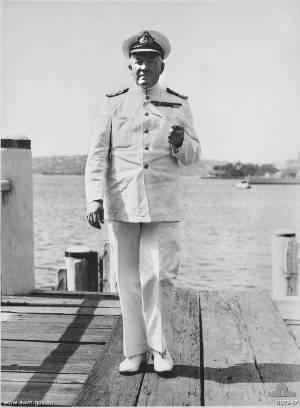Gerard Muirhead-Gould facts for kids
Quick facts for kids
Gerard Muirhead-Gould
|
|
|---|---|

Commodore Muirhead-Gould in May 1941
|
|
| Born | 29 May 1889 London, England |
| Died | 26 June 1945 (aged 56) Wilhelmshaven, Germany |
| Allegiance | United Kingdom |
| Service/ |
Royal Navy |
| Years of service | 1904–1945 |
| Rank | Rear Admiral |
| Commands held | Flag Officer, Western Germany (1945–1946) Flag Officer, Wilhelmshaven (1944–1945) Flag Officer-in-Charge Sydney (1940–44) HMS Devonshire (1936–39) HMS Active (1932–33) HMS Bluebell (1926–27) |
| Battles/wars | First World War Second World War |
| Awards | Distinguished Service Cross Mentioned in Despatches Legion of Honour (France) Order of the Redeemer (Greece) |
Gerard Charles Muirhead-Gould (born May 29, 1889 – died June 26, 1945) was a brave officer in the Royal Navy. He reached the rank of Rear Admiral. He was also awarded the Distinguished Service Cross for his courage.
Contents
Gerard Muirhead-Gould was born in London, England, on May 29, 1889. He joined the Royal Naval Cadets in January 1904, starting his long career at sea.
Serving in World War I
During the First World War, Muirhead-Gould showed great bravery. He received several important awards for his actions. These included the Distinguished Service Cross from the United Kingdom. He also received awards from other countries, like the French Legion of Honour and the Greek Order of the Redeemer. These awards showed his excellent service.
From 1933 to 1936, Muirhead-Gould worked for the Naval Intelligence Division. This was a special group that gathered information about other navies. He was stationed at the British Embassy in Berlin, Germany. During this time, he secretly shared information with Winston Churchill. Churchill later became the Prime Minister of the United Kingdom. Muirhead-Gould told him about Germany's growing military power. This was important because it went against agreements made after the First World War.
World War II Service
When the Second World War began, Muirhead-Gould had a heart condition. This meant he could not go to sea on ships. Instead, he took on important roles on land.
Investigating the Royal Oak Sinking
In October 1939, a British battleship called HMS Royal Oak was sunk. It was anchored safely in Scapa Flow, a harbour in Scotland. A German submarine, German submarine U-47, managed to get into the harbour and sink the ship. This was a big shock. The navy set up an investigation to find out how this happened. Muirhead-Gould was one of the three senior officers on this special team. Their job was to figure out what went wrong and how to stop it from happening again.
Commanding Sydney Harbour Defenses
In February 1940, Muirhead-Gould was put in charge of Sydney Harbour in Australia. He stayed in this important role until September 1944. However, he was not very popular with the Australian sailors and officers working under him.
Japanese Submarine Attack
In May 1942, Sydney Harbour was attacked by Japanese midget submarines. These were small, two-person submarines. Muirhead-Gould was the most senior Allied officer there. At first, he did not believe reports of enemy submarines in the harbour. He reportedly said, "What are you all playing at, running up and down the harbour dropping depth charges and talking about enemy subs in the harbour? There's not one to be seen." Even when his crew insisted they had seen a submarine, he was not convinced. He even joked, "If you see another sub, see if the captain has a black beard. I'd like to meet him." Despite his initial doubts, the attack did happen, and it was a serious event.
Later War Service and Death
Because of his earlier experience in Germany, Muirhead-Gould was given a new role in 1944. He became the Flag Officer, Wilhelmshaven. This meant he was in charge of the German naval base at Wilhelmshaven after it was captured by Allied forces in May 1945. His command was later renamed Flag Officer, Western Germany. Sadly, he suffered a fatal heart attack there on June 26, 1945.

